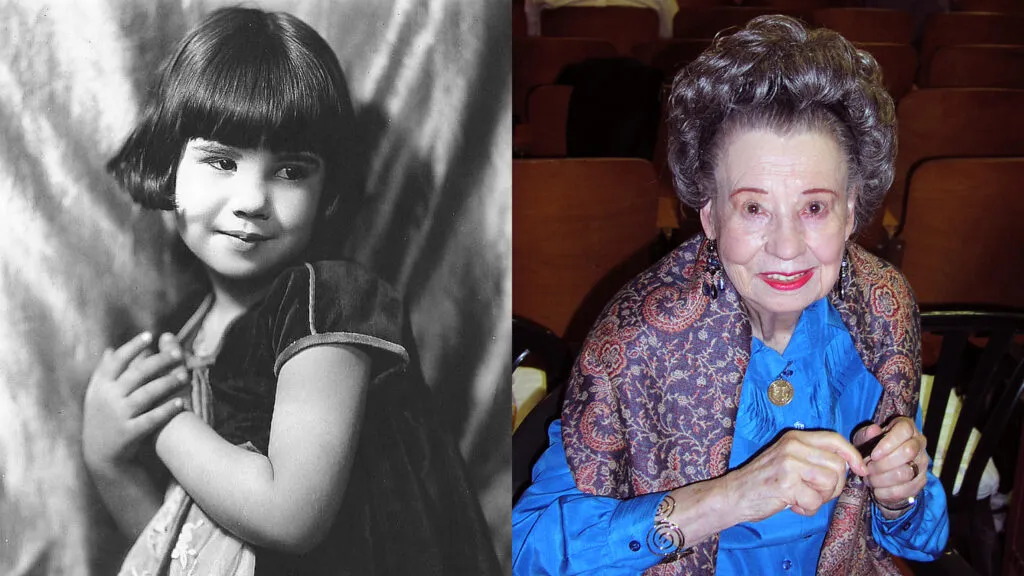Born Peggy-Jean Montgomery in San Diego, California, Diana Serra Cary was, as Baby Peggy, a bona fide movie star in her day. The former child star passed away at the age of 101 on February 24, 2020.
Cary’s father, Jack Montgomery, worked as a cowboy for some years before entering the movie business, where he served as a stuntman and extra and even did some stand-in work for western star Tom Mix.
Cary was discovered at the age of 19 months when she accompanied her mother on a visit to see her father, who was then working at Century Studios in Hollywood. Director Fred Fishbach, impressed by the young girl’s behavior and ability to take direction (from her parents, that is), cast her in a short subject opposite Century’s popular canine star, Brownie the Wonder Dog. When that collaboration proved to be a success, she was signed to a long-term contract.
From 1921 to 1924, Cary appeared in nearly 150 comedy shorts for Century. These short films often parodied other movies of the day, so Cary was sometimes asked to satirize popular stars. In 1923’s Peg o’ the Movies, for example, she did take-offs on both Rudolph Valentino and Pola Negri.
Cary eventually began to star in full-length dramatic features for Universal. These films were “A” pictures, dubbed “Universal Jewels,” which was the studio’s designation for its top-shelf offerings.
It’s said that Cary received more than 1.2 million fan letters in a single year. She was so popular that between pictures, she was sent on nationwide promotional tours, making public appearances along the way to promote her movies.
By 1923, Universal was paying Cary $1.5 million a year (more than $20 million today). Her face also appeared on a wide range of commercial products, from dolls in her likeness to sheet music, jewelry and milk. It’s said that none other than young Judy Garland owned a Baby Peggy doll.
In what was not an uncommon story for the era, her parents spent the money Cary had earned, putting nothing aside for her, and her movie career came to a sudden halt in 1925 when her father had a falling out with a producer over her salary and cancelled her contract.
“[My parents] did some silly things,” Cary told The Hollywood Reporter, “but they didn’t do them viciously.”
Cary came to her family’s financial rescue by performing up to eight shows a day in a successful stint in vaudeville, but with a stage name like Baby Peggy, her career was bound to tail off as she grew into young womanhood. It was a relief to her when her career slowed down, but her parents, who were still relying on her income, kept the pressure on her, so despite an aversion to the film industry, she returned to pictures, playing bit parts and doing extra work.
Finally, in 1938, Cary appeared in her last motion picture, Having Wonderful Time. Having risen at a young age to the top of the acting profession but with little to show for it, one might expect Cary to have been embittered, but instead she buckled down and forged a new path for herself.
She began to work as a writer in radio, changing her first name to Diana because she feared she would otherwise always be thought of as “Baby Peggy” by those she met in both her personal and professional lives. As for the name that she now uses—she changed it when she was 61—Serra is her confirmation name from her conversion to Catholicism, and her last name comes from her second husband, artist Robert “Bob” Cary, whom she wed in 1954. Their marriage lasted nearly 50 years until his passing.
In her later years, Cary authored several volumes of nonfiction, among them The Hollywood Posse: The Story of a Gallant Band of Horsemen Who Made Movie History, Hollywood’s Children: An Inside Account of the Child Star Era and Jackie Coogan: The World’s Boy King: A Biography of Hollywood’s Legendary Child Star. She also penned an autobiography, What Ever Happened to Baby Peggy: The Autobiography of Hollywood’s Pioneer Child Star.
Cary lived with her son and his family in California and continued to hear from fans, young and old. She also attended various movie events and screenings when she could. And she continuted to write almost till the end of her life. In 2018, at 99, she self-published her first novel, a work of historical fiction called The Drowning of the Moon, which she describes as “an epic tale,” set in “the fascinating Mexican-American colonial Empire of New Spain.”
“Its protagonist,” Cary told The Hollywood Reporter, “is a self-assured young noblewoman of a silver-mining dynasty, growing up in Guanajuato, a city of palaces in the mountains of northwestern colonial Spanish Mexico. The book begins with the milestone of her christening in 1756.”
Movie stardom, success on the stage, the publication of several well-received books, a happy marriage and a foundation of faith: Cary’s was truly a long life well lived.





